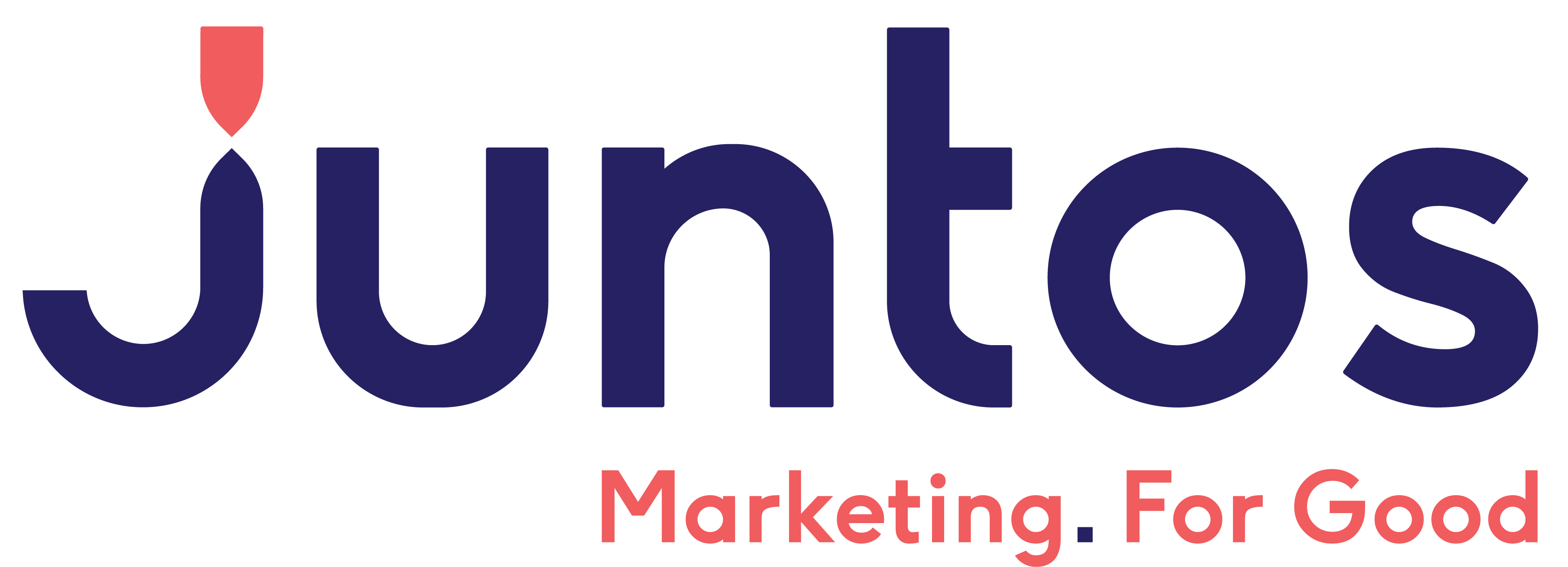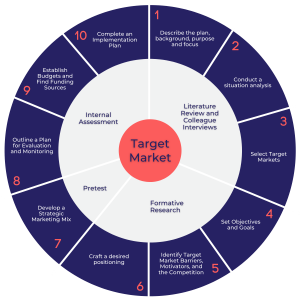
Social marketing (not to be confused with social media marketing), is a highly specialised approach to developing marketing activities, where the overarching goal is to change or maintain a population’s behaviour. Whether it is a campaign that encourages people to stop smoking, or one that inspires employees to carpool on their journey to work, the ultimate aim is to enhance and improve people’s lives.
What is social marketing?
Whereas some approaches to marketing may be considered by some to be subjective (or, at worst, a shot in the dark), the social marketing process follows a consistent and structured framework, using established methodologies to build a deep understanding of the target audience at-hand (their motivations, desires and barriers), to develop campaigns that truly engage and get results.
At Juntos Marketing, we are experienced social marketing specialists, having worked on a range of research-informed health and social change campaigns over the years. We are also regular attendees and speakers at the International Social Marketing Conference – brought to you by the Australian Association of Social Marketing – gathering of academics and practitioners from around the world.
In this article we share some of our key learnings from this year’s conference and explore how the principles of social marketing can be applied to any organisation seeking to influence and engage with its audience.
How social marketing crosses a range of sectors.
Whilst social marketing is a uniquely specialist field that involves both academics and marketing practitioners, it’s a term that many businesses are not familiar with as it’s more commonly used by government and health organisations for behaviour change campaigns.
However, our experience has shown us that the benefits of the social marketing process can cross-over from the public sector to other businesses, particularly during this time of unprecedented turbulence and change. The fact is it’s never been more important for businesses to truly understand and engage with their customers and employees, guiding them through periods of upheaval to improved outcomes in their lives and work.
Examples of social marketing is a corporate setting might be internal communications to support staff through business transformation; or a campaign to build awareness of a company’s positive stance on Environmental, Social and Governance issues (ESG), an area of growing importance for forward-thinking businesses.
Taking this perspective, there are a number of key principles of social marketing can be applied across a range of B2B and B2C sectors to enhance their marketing efforts and drive real engagement with their audiences.
3 things we learned from the 2022 International Social Marketing Conference.
At this year’s International Social Marketing Conference, our team were exposed to the latest thinking from leading social marketing practitioners around the world. We also presented our own most recent social marketing campaign, which tackled a debilitating and commonly overlooked oral health condition.
Below are three of our key outtakes from the conference which, we think, can be applied to any organisation looking to harness the principles of social marketing to engage and drive change:
1. Language matters
Professor Rebekah Russell-Bennett from QUT kicked off the conference with inspiring keynote speech about the power of positive language in marketing. In it, she noted that many behaviour change campaigns, often where the audience in question is a vulnerable group, take a ‘deficit-based approach’ in their language, in other words, messaging that focusses on the problem behaviours rather than the solution.
However, Professor Russell-Bennett says there is a huge opportunity to marketers to change this perspective, shifting to positive and empowering language, which helps to reframe the narrative and the solution for the audience at hand. Rather than feeling overwhelmed, people instead feel empowered and a part of their own solution.
An example of this was an innovative campaign, (also presented at the conference) by Sustainability Victoria, which set out to eliminate high levels of food wastage. Interestingly, their findings showed that the audience in question did not identify as people who wasted food so it was important for campaign messaging not to talk about the issue at hand but, instead, to shift the focus on the many benefits of meal planning and making lists. This ensured that people stayed engaged with the campaign and identified with it.
This is an important learning for any organisation developing campaigns that focus more on driving engagement with staff and customers. Particularly when managing times of change and transformation, it’s important for organisations to be mindful of the language they use and how they frame the narrative, considering the impact a negative slant might have on final outcomes.
2. When it comes to customer insights, dig deep
A key strength of social marketing campaigns is the rigour they employ to gain genuine insights into their audiences – the attitudes, motivations and challenges faced.
While many marketers agree that the campaign ideation process needs to be supported by ‘audience insights’, we find that the term ‘insights’ is often used to describe easily identified facts or observations about their audience. Generating insights requires the additional step of interrogating the meaning behind the data, often through qualitative research, to uncover a nugget of truth that is not immediately apparent and, sometimes, surprising.
An interesting campaign presented at the conference, which illustrates this point, was developed by Sexual Health & Innovation Researchers Natalie Bowring and Rebekah Russell-Bennett. The goal was to increase condom use in the over-50s market. The work took on an in-depth, qualitative research approach, including co-design, set out to understand, in some depth, the reasons why condom use is so low in this group; Over-50s having one of the highest rates of STIs compared to other age-groups.
What was uncovered were attitudes based on a lack of education in their younger years, together with a deep understanding of the audience’s motivations for sex as being the shared experience it gives them with a partner. Uncovering these insights gave a much richer foundation for developing a meaningful campaign that would truly engage and change behaviour.
3. The importance of testing and tracking
As the old adage goes, ‘the proof is in the pudding’. Whilst you can devise and develop an insight-led campaign with the potential to engage your audience, the result will ultimately come down to the numbers, post-campaign.
Tracking and campaign evaluation is often something that can fall by the wayside, particularly when the tracking continues for several months post campaign. However, it is a vital component of any successful social marketing campaign.
In-depth tracking of all aspects of the campaign is used to clearly gauge the outcomes and ascertain which elements worked and which did not.
With the ability to properly gauge and measure results, marketers are able to build and optimise future campaigns for success, limiting the risk on their investment.
A social marketing campaign that spoke to this point at the conference was an innovative example from Japan, presented by Yoko Uryuhara. This campaign aimed to increase the number of people registering to be organ donors (currently only 1% of the Japanese population is on the register). With a barrier being identified around young people finding it difficult to instigate uncomfortable conversations with family about their wish to register, the main channel for communication was a dedicated music festival that encouraged these conversations through a mix of music and live discussions with a range of people, including those currently on the waiting list to receive an organ.
Whilst the festival was considered a great vehicle to raise awareness and get people talking, the only post-event sentiment tracking of attendees was a form included on a flyer that was distributed as people were leaving. Unsurprisingly, only a small percentage of people filled in the form and, whilst results were strong, the sample was not robust enough to truly gauge the effectiveness of the campaign and whether it should be rolled-out to other regions in the future.
When planning any campaign, it’s important to consider your approach to tracking and measurement from the very start of the process. Having a clear understanding of campaign performance may help you to sell in future campaigns to the wider business, demonstrating ROI and alleviating risk.
Final Word.
Overall, the conference was fantastic opportunity for the Juntos Team to stay abreast of the latest developments in the practice of behaviour change. It also gave us an opportunity to reflect on how the learnings gained can be used beyond traditional behaviours change campaigns to improve engagement across a multitude of sectors.
As social marketing and research specialists, our team are experienced in helping organisations to deliver effective, insight-driven content and campaigns that drive genuine engagement and impact. Could your business benefit from strategic, insight-led marketing solutions? Give us a call today for a no-obligation chat.
FROM THE BLOG
You might also be interested in
Juntos can help you boost your marketing investment by
- Helping you understand your customers better
- Helping your content reach its audience
- Providing expert guidance on your marketing strategy
- Creating content that stands out
Find out how Juntos can help your business thrive
Shoot through your details and we’ll be in touch within 24 hours.

